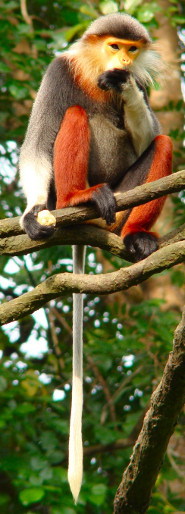Thursday 29 March 2012 Douc Langur - Endangered Colorful Asian Monkey
 The douc langur (Pygathrix nemaeus) is also known as the red-shanked douc or the costumed ape. The word "douc" is pronounced "dook." This endearing but endangered monkey lives in the forests of Southeast Asia and can still be found in decreasing numbers in Vietnam, Cambodia, Thailand and Laos. The douc labor relies on forests for food, sleeping sites and protection.
The douc langur (Pygathrix nemaeus) is also known as the red-shanked douc or the costumed ape. The word "douc" is pronounced "dook." This endearing but endangered monkey lives in the forests of Southeast Asia and can still be found in decreasing numbers in Vietnam, Cambodia, Thailand and Laos. The douc labor relies on forests for food, sleeping sites and protection.The douc langur is endangered due to their forests being cut down and due to poaching. The population almost went extinct during the Vietnam War because the plant-killing chemical Agent Orange decimated the douc langur’s forests. Although protected by international law, douc langurs are still hunted for meat and for the illegal pet trade. Their body parts are also used in traditional medicine and magic spells. Birds of prey hunt the babies.
Physical Description
Douc langurs are slender monkeys with rangy limbs. They sport a blue-gray body with rusty red hind legs and cheeks. Their rounded, hairless golden faces are fringed with a white ruff and whiskers. Their eyes are dark brown. Their long tails, which act as a fifth limb, are blue-grey with a white tip. Baby douc langurs are often born tan or a pale rusty red and acquire their adult coloring as they mature.
Both males and females look alike, but males are larger and heavier. Males grow to be 22 to 26. 45 pounds (10 to 12 kilograms) while females only tip the scales at 11 to 17.6 pounds (5 to 8 kilograms.) From head to rump, males grow to a length of 23.62 inches (60 centimeters) while females grow to 21.65 inches (55 centimeters.) Female tails grow up to 23.62 inches (60 centimeters) long, while male tails can reach lengths of 29.13 inches (74 centimeters.)
Life Cycle and Behavior
Much still needs to be learned about the douc langur’s behavior in order to better protect the species. This shy monkey prefers to live as high in the treetops as possible, making it difficult to study. It is known that they are like people in that they are active in the day and sleep at night. Most of their diet consists of leaves and buds. In order to get enough nutrition, the douc langurs often sport huge pot bellies that can make up one-fourth of the monkey’s body weight.
Douc langurs travel in small family troops. Breeding season lasts from February to June. The female gives birth to one baby after a 210 day pregnancy. Females can only breed every other year and do not become sexually mature until they are five. With luck, a douc langur can live for 20 years.
Picture of the douc langur by Bjørn Christian Tørrissen, licensed under the Creative Commons Attribution-Share Alike 3.0 Unported license and GFDL. You can help spreading the word about this animal by liking it on facebook
